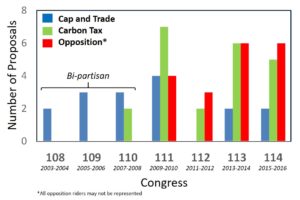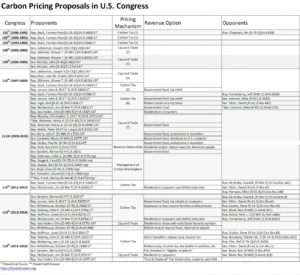Carbon Pricing in the U.S. Congress
Posted: December 7, 2016
Carbon pricing has seen a rocky road in the U.S. Congress. After a slow start with proposals as early as 1990, a push with bi-partisan support came in 2003-2008. But by the 111th Congress (2009-2010) Democrats were the primary proponents. The Waxman-Markey cap-and-trade bill passed the House after significant compromising in 2009, but failed in the Senate. Since then proponents’ bills have shifted more to carbon tax, (all from Democrats) and opposition has increased (all from Republicans). There are signs that some Congressional Republicans are recognizing climate change and moving to find solutions. Whether carbon pricing is among the solutions remains to be seen.
a push with bi-partisan support came in 2003-2008. But by the 111th Congress (2009-2010) Democrats were the primary proponents. The Waxman-Markey cap-and-trade bill passed the House after significant compromising in 2009, but failed in the Senate. Since then proponents’ bills have shifted more to carbon tax, (all from Democrats) and opposition has increased (all from Republicans). There are signs that some Congressional Republicans are recognizing climate change and moving to find solutions. Whether carbon pricing is among the solutions remains to be seen.
History in Brief
The first proposal for a price on carbon, in 1990, followed the First Assessment Report by the Intergovernmental Panel on Climate Change (IPCC) which set out some data that climate change may be a threat. Rep. Fortney Pete Stark [D-CA-13] proposed a carbon tax in 1990, 1991 and 1993. There was bi-partisan opposition in 1990 – in fact the majority of cosponsors opposing the resolution were Democrats.
 There was an attempt at bi-partisanship in the years 2003-2008. Versions of the Climate Stewardship Act, a cap and trade proposal, were introduced in one or both houses repeatedly, but with no traction. These several bills included the McCain-Leiberman proposals in the Senate and the Gilchrest-Olver proposals in the House.
There was an attempt at bi-partisanship in the years 2003-2008. Versions of the Climate Stewardship Act, a cap and trade proposal, were introduced in one or both houses repeatedly, but with no traction. These several bills included the McCain-Leiberman proposals in the Senate and the Gilchrest-Olver proposals in the House.
Click on figure to enlarge
The IPCC Fourth Assessment in 2007 showed much more compelling evidence of the threat of climate change, and Democrats rallied with twenty-one proposals for a price on carbon or related proposals from 2010 to 2012 (111th Congress). Bob Inglis [R-SC-4] was the sole Republican with a proposal. He lost his next election bid. The Waxman-Markey proposal for cap and trade (H.R.2454) passed the House with a vote of 219-212, but was stopped in committee in the Senate.
Throughout the years 2007 to 2014 the Democratic proposals most typically suggested the revenue be sent to a government fund – each bill suggesting its own creative name for the fund – and/or a proposal to send all or some of the revenue back to the American people. Few of the proposals described how the revenue would be divided among the “American people”.
Polarization into very vigorous “pro” and “con” camps grew from 2010 and continues through the 114th Congress (2014-2016).
Until 2009-2010, opposition was there but not particularly vocal. But that changed. While after 2010 the Democrats trotted out similar carbon pricing proposals to those already tried, Republicans organized strong opposition. There were six Republican proposals to stop carbon pricing in the 113th Congress (2013-2014), one with 155 cosponsors.
The 114th Congress started with a bit of optimism. Two proposals included decreasing corporate income tax as one of the revenue options – a shift toward more business-friendly ideas. But by the end of 2016, the familiar animosity and strong polarization were still evident.
